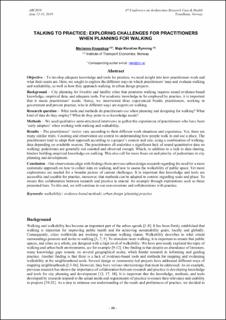| dc.description.abstract | Objective – To develop adequate knowledge and tools for practice, we need insight into how practitioners work and what their needs are. Here, we sought to explore the different ways in which practitioners’ map and evaluate walking and walkability, as well as how they approach walking, in urban design projects.
Background – City planning for liveable and healthy cities that promotes walking requires sound evidence-based knowledge, empirical data, and adequate tools. For academic knowledge to be employed by practice, it is important that it meets practitioners’ needs. Hence, we interviewed three experienced Nordic practitioners, working in government and private practice, who in different ways are experts on walking.
Research question – What tools and methods do practitioners use when planning and designing for walking? What kind of data do they employ? What do they point to as knowledge needs?
Methods – We used qualitative semi-structured interviews to gather the experiences of practitioners who have been ‘early adapters’ when working with walking and walkability.
Results – The practitioners’ stories vary according to their different work situations and experience. Yet, there are many similar traits. Counting and observation are central to understanding how people walk in and use a place. The practitioners tend to adapt their approach according to a project’s context and size, using a combination of walkingdata depending on available sources. The practitioners all underline a significant lack of sound quantitative data on walking; pedestrians are generally not counted and observed enough. Which, in addition to a lack in data sharing, hinders building empirical knowledge on walking. This also call for more focus on and priority of pedestrians in city planning and development.
Conclusion – Our observations align with findings from previous urban design-research regarding the need for a more systematic approach on how to collect data on walking, and how to assess the walkability of public space. Yet more explorations are needed for a broader picture of current challenges. It is important that knowledge and tools are accessible and useable for practice, moreover, that methods can be adapted to context regarding scale and place. To ensure this collaboration between research and practice is crucial, for example through explorations such as those presented here. To this end, we will continue to our conversations and collaborations with practice. | |

